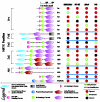Nonreceptor tyrosine kinases in prostate cancer
- PMID: 17357254
- PMCID: PMC1813931
- DOI: 10.1593/neo.06694
Nonreceptor tyrosine kinases in prostate cancer
Abstract
Background: Carcinoma of the prostate (CaP) is the most commonly diagnosed cancer in men in the United States. Signal transduction molecules such as tyrosine kinases play important roles in CaP. Src, a nonreceptor tyrosine kinase (NRTK) and the first proto-oncogene discovered is shown to participate in processes such as cell proliferation and migration in CaP. Underscoring NRTK's and, specifically, Src's importance in cancer is the recent approval by the US Food and Drug Administration of dasatinib, the first commercial Src inhibitor for clinical use in chronic myelogenous leukemia (CML). In this review we will focus on NRTKs and their roles in the biology of CaP.
Materials and methods: Publicly available literature from PubMed regarding the topic of members of NRTKs in CaP was searched and reviewed.
Results: Src, FAK, JaK1/2, and ETK are involved in processes indispensable to the biology of CaP: cell growth, migration, invasion, angiogenesis, and apoptosis.
Conclusions: Src emerges as a common signaling and regulatory molecule in multiple biological processes in CaP. Src's relative importance in particular stages of CaP, however, required further definition. Continued investigation of NRTKs will increase our understanding of their biological function and potential role as new therapeutic targets.
Figures




References
-
- Jemal A, Siegel R, Ward E, Murray T, Xu J, Smigal C, Thun MJ. Cancer statistics, 2006. CA Cancer J Clin. 2006;56:106–130. - PubMed
-
- Nam S, Kim D, Cheng JQ, Zhang S, Lee JH, Buettner R, Mirosevich J, Lee FY, Jove R. Action of the Src family kinase inhibitor, dasatinib (BMS-354825), on human prostate cancer cells. Cancer Res. 2005;65:9185–9189. - PubMed
-
- Moore TM, Garg R, Johnson C, Coptcoat MJ, Ridley AJ, Morris JD. PSK, a novel STE20-like kinase derived from prostatic carcinoma that activates the c-Jun N-terminal kinase mitogen-activated protein kinase pathway and regulates actin cytoskeletal organization. J Biol Chem. 2000;275:4311–4322. - PubMed
-
- Boggon TJ, Eck MJ. Structure and regulation of Src family kinases. Oncogene. 2004;23:7918–7927. - PubMed
Publication types
MeSH terms
Substances
LinkOut - more resources
Full Text Sources
Other Literature Sources
Medical
Research Materials
Miscellaneous
